Forum Replies Created
-
AuthorPosts
-
 Nick JamesParticipant
Nick JamesParticipantYes, a very impressive achievement from Ron.
 Nick JamesParticipant
Nick JamesParticipantReally nice animation although I can see the difference between Hubble and your setup…
 Nick JamesParticipant
Nick JamesParticipantThat was interesting breakfast reading. The last time I imaged one of these was when V838 Mon erupted 18 years ago. CCDs were much smaller then!
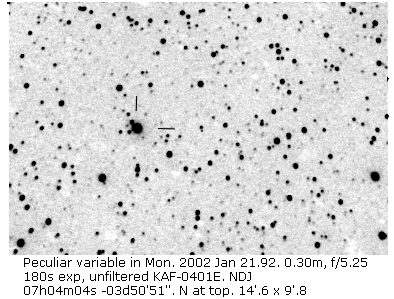
 Nick JamesParticipant
Nick JamesParticipantMy original post, which I’ve deleted, marked the wrong object. The new one is correct but has a later timestamp. Robin’s reply hasn’t violated the rules of causality.
 Nick JamesParticipant
Nick JamesParticipantHere it is from 2021-01-30T23:46:28 against a very lumpy galaxy background. Astrometry matches the quoted position to within 1 arcsec.
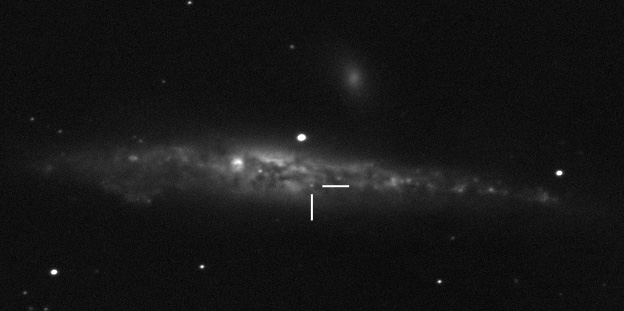
 Nick JamesParticipant
Nick JamesParticipantHere it is again from Friday morning. The variable is still around mag 18 so not doing a lot.
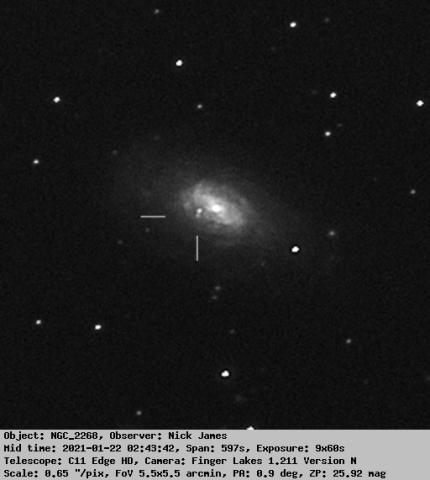
 Nick JamesParticipant
Nick JamesParticipantNot to do with darks. I’m using the same darks for my camera that I’ve been using since the beginning of last year. I have a library of darks for each exposure that I use and I never scale them. CMOS cameras generally have much lower read noise than CCD cameras so stacking loads of short exposures works well. This has benefits in the stacking process since outliers (satellite trails, the odd badly guided image etc. can get rejected in the stacking process. You are right that CCD sensors are becoming specialist items now limited to a very few applications. Even cameras on spacecraft are gradually making the transition.
 Nick JamesParticipant
Nick JamesParticipantAssuming you can find the lost widget this is what to expect from the NEQ6 once you’ve modded it. This is the unguided performance. In this case the exposures are 60s so the graph covers around an hour. The Dec drift is due to polar misalignment (this is a “portable” mount) but the 8 minute periodic error in RA is clear and it has a peak-to-peak amplitude of around 15 arcsec (the scale is pixels which are 2.1″). It is very smooth too and guides out easily if you can be bothered. I don’t bother and just rely on relatively short exposures (60s) and stacking. That is a pretty good approach for CMOS sensors anyway and makes for a very easy imaging setup. This plot corresponds to the performance obtaining this image.
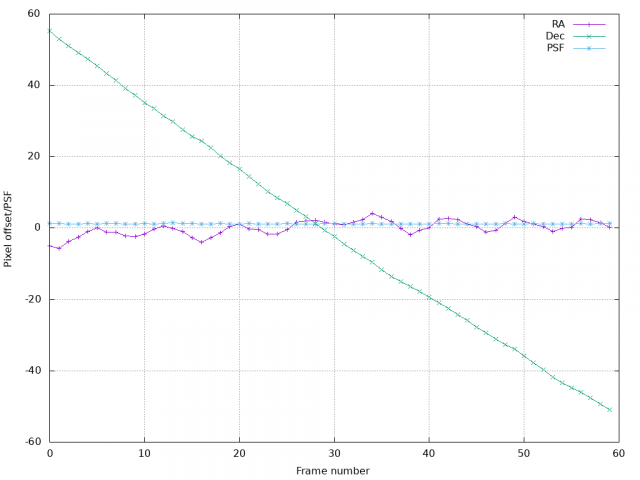
 Nick JamesParticipant
Nick JamesParticipantAll the pain is definitely worth it. I have a belt-modded NEQ6 and it tracks very well with remarkably small and smooth PE for such small gears.
Presumably, as Haynes manuals used to say: “reassembly is the reverse of disassembly” although I’ve generally found that springs make disassembly a one-way process.
 Nick JamesParticipant
Nick JamesParticipantYes, I think a hot water bottle is a bit pathetic really. What kind of engineer are you? A propane blowtorch would be better, particularly if the thread is loctited. When I was doing some work on my mount in the summer I bought one of the cheap cookery ones from Amazon. It worked for me. If it doesn’t work to free your thread you can always make a creme brulee.
 Nick JamesParticipant
Nick JamesParticipantCan’t help you with the NEQ6 (I have one of the belt-modded ones but the mod was done before I bought it) but I’m sure Mrs. Beeton won’t be too happy to see her cookbook used in this way.
 Nick JamesParticipant
Nick JamesParticipantYes, I thought this one would be a challenge. It had a whole galaxy to go off in and it did it next to a relatively bright field star! How big is the slit you use and can you orient it to avoid that star?
 Nick JamesParticipant
Nick JamesParticipantHere’s an image of it from Jan 12.9. It is a difficult object to measure since there is a 17th mag star around 3 arcsec north of it. I get 17.9 tonight.
 Nick JamesParticipant
Nick JamesParticipantJust checked my images taken earlier this evening in thick fog. I get 15.4 (unfiltered vs Gaia DR2 G) at Jan 9.73 so it does look like an outburst. Image quality was rubbish though due to the fog. The last decent image I have of the field was Jan 6.73 when it was 17.08.
 Nick JamesParticipant
Nick JamesParticipantCOVID meant that I was at home a lot more than I would normally have been, particularly in the Spring and early summer when the weather was excellent. I managed to do some imaging on 170 nights in 2020 (compared to 90 in 2019). Some of this was due to the better weather but most was due to the fact that I was around to use the telescope! Less subjectively the number of sporadic meteors picked up by my two meteor cameras remained similar to previous years (see the graph below).
There were many observing highlights in 2020. Sitting out in wonderful weather each evening in the spring and early summer watching Venus gradually sink into a contrail-free twilight, capturing an outburst of comet 29P just a few minutes after it had started, watching the breakup of C/2019 Y4 (ATLAS) in night after night of clear skies and then, of course, there was the wonderful C/2020 F3 (NEOWISE) in July. One of my most memorable nights was on July 11/12 when that beautiful comet was joined by bright NLCs on a perfect summer evening. Sadly, the following week I should have been on La Palma and I wonder what comet images I would have got from there but COVID put paid to that.
Finally, at the end of the year, I was amazingly privileged to see the December 14 Total Solar Eclipse from Argentina as one of less than 100 foreigners let into the country. Many thanks to AstroTrails for managing to arrange that despite the international travel situation.
All-in-all a very memorable year from an astronomical viewpoint but I do hope that things start to get back to normal in 2021. I do miss travel and pubs and all the things of normal daily life that we used to take for granted.
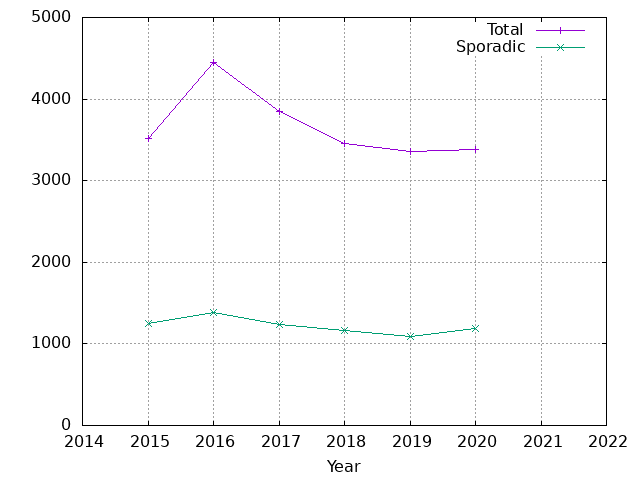
 Nick JamesParticipant
Nick JamesParticipantYes, clear at the Astro Trails site in Argentina. Fantastic view although a bit windy. https://britastro.org/observations/observation.php?id=20201214_214258_b6606c0d197cc531
 Nick JamesParticipant
Nick JamesParticipantHi Graham, I can’t speak for other sections but as far as the Comet Section is concerned you should continue to submit images directly (info on how to do that is here). Once they’ve been checked the images will then appear in the Comet Section archive here, and through Dominic’s coding magic, they will also appear in the new gallery.
 Nick JamesParticipant
Nick JamesParticipantIt certainly looks optical rather than electronic to me. I can’t think how an electronic failure could cause this. Could it be frost forming on the sensor? That is normally only a temporary problem but I can’t think of anything else that would have such a weird effect.
 Nick JamesParticipant
Nick JamesParticipantThanks for all the links and references. I hadn’t realised that the Solar atmospheric “tides” were actually thermal rather than gravitational unlike the lunar one which is definitely gravitational or that the solar tides lead to small (mm) deformations in the solid body of the earth. Yet another small cause of the increase in day length. Anyway, I have a big dataset and will write some code to do a proper analysis of this for the sun and moon and see what I can find.
 Nick JamesParticipant
Nick JamesParticipantThat’s great news and very well deserved.
Nick.
-
AuthorPosts
